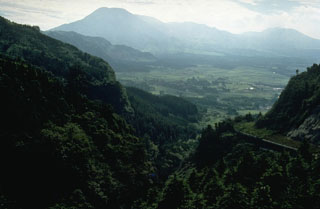Report on Asosan (Japan) — 15 May-21 May 2024
Smithsonian Institution / US Geological Survey
Weekly Volcanic Activity Report, 15 May-21 May 2024
Managing Editor: Sally Sennert.
Please cite this report as:
Global Volcanism Program, 2024. Report on Asosan (Japan) (Sennert, S, ed.). Weekly Volcanic Activity Report, 15 May-21 May 2024. Smithsonian Institution and US Geological Survey.
Asosan
Japan
32.8849°N, 131.085°E; summit elev. 1592 m
All times are local (unless otherwise noted)
JMA reported continuing unrest at Asosan. Sulfur dioxide gas emissions were somewhat high, averaging 1,600 tons per day (t/d), when measured during a field survey on 9 May. The amplitude of volcanic tremors began to increase at around 0600 on 15 May and increased again round 0900. At 0920 the Alert Level was raised to 2 (on a scale of 1-5) and the public was warned to stay at least 1 km away from the crater. During a field visit later that morning scientists observed a hot spring within the pool on the Nakadake Crater floor and measured sulfur dioxide emissions of 800 t/d. Volcanic tremor amplitude was variable and decreased to low levels by 0700 on 16 May. White steam-and-gas plumes rose 100-300 m above the crater rim during 16-17 May and crater incandescence was occasionally visible in webcam images at night. Sulfur dioxide emissions had decreased to 500 t/d on 17 May.
Geological Summary. The 24-km-wide Asosan caldera was formed during four major explosive eruptions from 300,000 to 90,000 years ago. These produced voluminous pyroclastic flows that covered much of Kyushu. The last of these, the Aso-4 eruption, produced more than 600 km3 of airfall tephra and pyroclastic-flow deposits. A group of 17 central cones was constructed in the middle of the caldera, one of which, Nakadake, is one of Japan's most active volcanoes. It was the location of Japan's first documented historical eruption in 553 CE. The Nakadake complex has remained active throughout the Holocene. Several other cones have been active during the Holocene, including the Kometsuka scoria cone as recently as about 210 CE. Historical eruptions have largely consisted of basaltic to basaltic andesite ash emission with periodic strombolian and phreatomagmatic activity. The summit crater of Nakadake is accessible by toll road and cable car, and is one of Kyushu's most popular tourist destinations.

